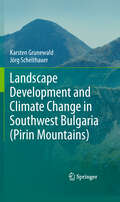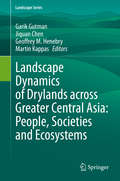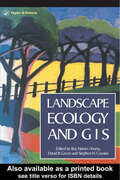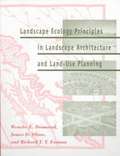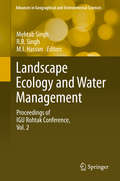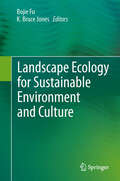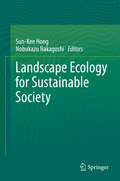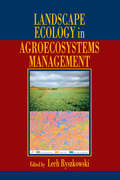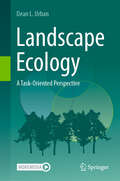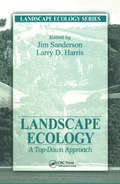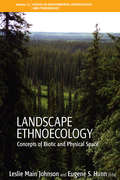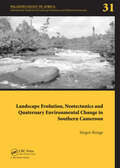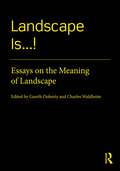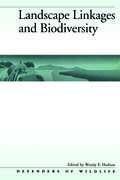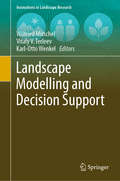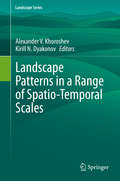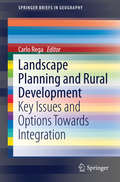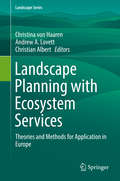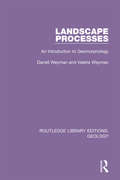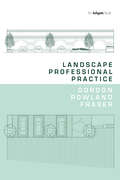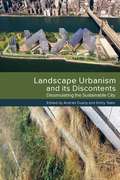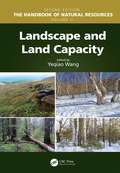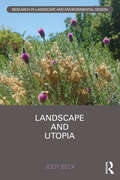- Table View
- List View
Landscape Development and Climate Change in Southwest Bulgaria (Pirin Mountains)
by Karsten Grunewald Jörg ScheithauerLandscape Development and Climate Change in Southwest Bulgaria aims to address some of the current limitations in our understanding of past Balkan climate and environment. High mountains and their ecosystems offer an outstanding opportunity for studies on the impact of climate change. The Balkan Mountains in Southeast Europe, situated at the transition between temperate and Mediterranean climate, are considered as very sensitive to historical and current global changes. The geoarchives lake sediment, peat and soil, long living trees and glaciers have been used to reconstruct the climatically-driven change of forest and treeline during the Holocene and the younger past. These processes are interrelated with complex ecological changes, as for example the seasonality of climate parameters. The landscape research approach with the analyses through multi-palaeo-geoecological proxies is new for the Balkans.
Landscape Dynamics of Drylands across Greater Central Asia: People, Societies and Ecosystems (Landscape Series #17)
by Martin Kappas Garik Gutman Jiquan Chen Geoffrey M. HenebryThis volume is a compilation of studies on interactions of changes in land cover, land use and climate with people, societies and ecosystems in drylands of Greater Central Asia. It explores the effects of collapse of socialist governance and management systems on land use in various parts of Central Asia, including former Soviet Union republics, Mongolia and northern drylands of China. Often, regional land-atmosphere feedbacks may have large global importance. Remote sensing is a primary tool in studying vast dryland territories where in situ observations are sporadic. State-of-the-art methods of satellite remote sensing combined with GIS and models are used to tackle science questions and provide an outlook of current changes at land surface and potential scenarios for the future. In 10 chapters, contributing authors cover topics such as water resources, effects of institutional changes on urban centers and agriculture, landscape dynamics, and the primary drivers of environmental changes in dryland environment. Satellite observations that have accumulated during the last five decades provide a rich time series of the dynamic land surface, enabling systematic analysis of changes in land cover and land use from space. The book is a truly international effort by a team of scientists from the U.S., Europe and Central Asia. It is directed at the broad science community including graduate students, academics and other professionals at all levels within natural and social sciences. In particular, it will appeal to geographers, environmental and social scientists, economists, agricultural scientists, and remote sensing specialists.
Landscape Ecology And Geographical Information Systems
by Roy Haines-Young David R.Green Steven CousinsThe landscape we see and live in is an important part or our everyday lives, be they urban or rural. Environmental concern has grown in recent years, as a result of public awareness of the detrimental impact industry, transport and tourism can have on the ecosystem. This book examines the role of the new technologies of geographical information sys
Landscape Ecology Principles in Landscape Architecture and Land-Use Planning
by Richard T. T. Forman Thomas C. Brown David M. Gillilan Wenche E. Dramstad James D. Olson Richard T. Forman Harvard University Graduate School of Design Staff Wenche DramstadLandscape ecology has emerged in the past decade as an important and useful tool for land-use planners and landscape architects. While professionals and scholars have begun to incorporate aspects of this new field into their work, there remains a need for a summary of key principles and how they might be applied in design and planning. This volume fills that need. It is a concise handbook that lists and illustrates key principles in the field, presenting specific examples of how the principles can be applied in a range of scales and diverse types of landscapes around the world. Chapters cover: patches -- size, number, and location edges and boundaries corridors and connectivity mosaics summaries of case studies from around the world
Landscape Ecology and Water Management
by R. B. Singh Mehtab Singh M. I. HassanThe over-exploitation of important earth resources such as land and water has led to a number of environment-related problems the world over. At the same time, land-use change caused by various human activities has led to extinction of many plant and animal habitats and species. In this context, the relevance of biodiversity for human survival is becoming a major international political issue as scientific evidence builds on the global health implications of biodiversity loss. These issues are closely linked with the issue of climate change, as many of the health risks due to climate change are associated with rapid degradation of biodiversity. This present work focuses on holistic natural resource-based spatio-temporal planning, development and management and considers them as essential to save the degraded ecosystem for sustainable resource management. Contributions are compiled in two volumes: 1. Climate Change and Biodiversity and 2. Landscape Ecology and Water Management. Geoinformatics along with its tools such as remote sensing and Geographical Information Systems (GIS) have been used in assessing the results of various environmental problems both physical and social. These volumes will be useful for geographers, geoscientists, hydrologists, landscape ecologists, environmentalists, engineers, planners and policy makers.
Landscape Ecology for Sustainable Environment and Culture
by Bojie Fu Bruce Jones KClimate change and the pressures of escalating human demands on the environment have had increasing impacts on landscapes across the world. In this book, world-class scholars discuss current and pressing issues regarding the landscape, landscape ecology, social and economic development, and adaptive management. Topics include the interaction between landscapes and ecological processes, landscape modeling, the application of landscape ecology in understanding cultural landscapes, biodiversity, climate change, landscape services, landscape planning, and adaptive management to provide a comprehensive view that allows readers to form their own opinions. Professor Bojie Fu is an Academician of Chinese Academy of Sciences and Chair of scientific committee at the Research Center for Eco-Environmental Sciences, Chinese Academy of Sciences, Beijing, China. Professor K. Bruce Jones is the Executive Director for Earth and Ecosystem Sciences Division at Desert Research Institute, University of Nevada, Las Vegas, USA.
Landscape Ecology for Sustainable Society
by Sun-Kee Hong Nobukazu NakagoshiThe research category of the landscape ecology, which researches the structure, functions, and the spatio-temporal changes of the ecological landscapes, has now been contributing to the human life and the shifts of the socio-economic paradigm. Global warming has been influencing the universal life patterns of the mankind which have been maintained in the past several hundreds of years. And it has been having the influences on the international social problems and economic problems. Although the diverse plans for adapting to the climate changes have been the topics of the conservations among the ecologists internationally, it is the reality that the speed of the changes of the environment has been quicker than the time it takes to complete the solutions. In order to maintain the sustainable earth and the sustainable society, the role of the landscape ecology has been coming to the fore. Especially, the theories and the methodologies of the landscape ecology have been applied to the multidisciplinary researches by going beyond the research category of ecology, including the maximization of the efficiencies of the land spaces, the management of the ecological space (habitats) in which the biological diversity can be maintained, the utilization of the resources that are absolutely needed by the human beings (Here, it is compressed to water, energy, and food), etc. and until reaching the human society. It is considered that, to that extent, the utilizations and the applications of the landscape ecology are very much needed for the diagnoses and the evaluations of the global environmental problems which have been proceeded with rapidly in the modernity.This book is not comprised of any general remarks that explain the theories and the methods of the landscape ecology. Already, based on the basic theories of the landscape ecology, the writers have conducted the investigations on the farm villages, the cities, and the coastal ecosystems. And, through the space analyses and interpretations, the structure and functions of the landscapes were analyzed. Of course, in this book, too, the diverse ecosystems and the landscape ecological methodologies regarding the land use have been presented. However, the core of this book focuses more on what role the landscape ecology must play for the materialization of a sustainable society in the future. At the farm villages, the sustainable agriculture will be presented, and, at the cities, the discussions on the green networks and the energies will be proceeded with. Also, regarding the coasts and the seas, a thesis on the safety of the life zones of the residents adjacent to the sea and on the conservation of the island ecosystems will be presented. The sustainable society is a system that is formed by having the sustainable development as a basis. It is considered to be one aspect within a kind of a sustainable process with regard to which the natural world and the human world coexist and are in a symbiotic relationship harmoniously. In order to maintain the biodiversity, the reasonable adjustments of the human activities, like the use of the resources, are absolutely needed. Without the biological resources, the cultural diversity of the human beings, too, cannot exist. Consequentially, recently and internationally, there are a lot of the case examples that express the biocultural diversity by linking the biological diversity with the cultural diversity. In this book, the role of the landscape ecology as an academic link which can connect the two possible, if possible, is highly expected. It is, indeed, the biocultural landscape. It can be said that this concept, also, is the interconnection of the multidisciplinary spaces that must be dealt with in the modern landscape ecology. Through this book, it is intended to present a new directionality which can contribute to the sustainable society at the same time as the organization of the theories and the methods of the landscape ecology.
Landscape Ecology in Agroecosystems Management
by Lech RyszkowskiSuccessful management of agricultural landscapes depends on the recognition of the relationships between the processes and the structures that maintain the system. The rapidly growing science of Landscape Ecology quantifies the ways these ecosystems interact and establishes a link between the activities in one region and repercussions in another. A
Landscape Ecology: A Task-Oriented Perspective
by Dean L UrbanThis is methods/tools textbook that covers the fundamental tasks in research and management at the landscape scale. It brings together tools from a range of disciplines and presents them in a natural workflow that a practitioner can appreciate. Alternative texts cover a narrower range of topics and/or present the information without reference to a natural workflow. The book begins with 2 fundamental applications that introduce the scope and challenges of working at the landscape scales (sampling design and species distribution modeling). These motivate several chapters that ‘digress’ to cover the primary tools that ecologists use to work with multivariate and spatial data. The book then returns to applications including site prioritization, interpreting (and forecasting) landscape change, and integrated assessment. The tasks themselves follow a logical workflow of collecting and analyzing data, applying the analyses to management decisions, and interpreting the outcomes of these decisions in an integrated framework. This book stems from two graduate-level courses in Landscape Ecology taught at the Nicholas School of the Environment at Duke University. The subject has evolved over time, from a concepts-based overview of what landscape ecology is, to a more applied practicum on how one does landscape ecology. As landscape ecology has matured as a discipline, its perspectives on spatial heterogeneity and scale have begun to permeate into a wide range of other fields including conservation biology, ecosystem management, and ecological restoration. Thus, this textbook will bring students from diverse backgrounds to a common level of understanding and will prepare them with the practical knowledge for a career in conservation and ecosystem management.
Landscape Ecology: A Top Down Approach (Landscape Ecology Series)
by Jim Sanderson Larry D. HarrisLandscape Ecology - a rapidly growing science - quantifies the ways ecosystems interact. It establishes links between activities in one region and repercussions in another. Landscape Ecology: A Top-Down Approach serves as a general introduction to this emerging area of study.In this book the authors take a "top down" approach. They believe that
Landscape Ethnoecology
by Leslie Main Johnson Eugene S. HunnAlthough anthropologists and cultural geographers have explored "place" in various senses, little cross-cultural examination of "kinds of place," or ecotopes, has been presented from an ethno-ecological perspective. In this volume, indigenous and local understandings of landscape are investigated in order to better understand how human communities relate to their terrestrial and aquatic resources. The contributors go beyond the traditional ecological knowledge (TEK) literature and offer valuable insights on ecology and on land and resources management, emphasizing the perception of landscape above the level of species and their folk classification. Focusing on the ways traditional people perceive and manage land and biotic resources within diverse regional and cultural settings, the contributors address theoretical issues and present case studies from North America, Mexico, Amazonia, tropical Asia, Africa and Europe.
Landscape Evolution, Neotectonics and Quaternary Environmental Change in Southern Cameroon: Palaeoecology of Africa Vol. 31, An International Yearbook of Landscape Evolution and Palaeoenvironments (Palaeoecology of Africa)
by Jürgen RungeFounded in 1966, the internationally recognized and acclaimed SeriesPalaeoecology of Africa publishes interdisciplinary scientific papers on landscape evolution and on former environments of the African continent. Beginning with topics such as changes in climate and vegetation cover, the papers expand horizons and interconnections to various typ
Landscape Is...!: Essays on the Meaning of Landscape
by Charles Waldheim Gareth DohertyLandscape Is...! examines the implicit biases and received meanings of landscape. Following on from the previous publication Is Landscape…? which examined the plural and promiscuous identities of the landscape idea, this companion volume reflects upon the diverse and multiple meanings of landscape as a discipline, profession, and medium. This book is intended for academics, researchers, and students in landscape architecture and cognate disciplines. Chapters address various overlooked aspects of landscape that develop, disturb, and diversify received understandings of the field. Framed as an inquiry into the relationship of landscape to the forms of human subjectivity, the book features contributions from leading voices who challenge the contemporary understandings of the field in relation to capital and class, race and gender, power and politics, and more.
Landscape Linkages and Biodiversity: Policies For A Sustainable Future
by Larry Harris Michael E. Soulé J. Michael Scott Wendy E. Hudson Blair Csuti Keith HayIn Landscape Linkages and Biodiversity experts explain biological diversity conservation, focusing on the need for protecting large areas of the most diverse ecosystems, and connecting those ecosystems with land corridors to allow species to move among them more easily.
Landscape Modelling and Decision Support (Innovations in Landscape Research)
by Wilfried Mirschel Vitaly V. Terleev Karl-Otto WenkelThis book contributes to a deeper understanding of landscape and regional modelling in general, and its broad range of facets with respect to various landscape parameters. It presents model approaches for a number of ecological and socio-economic landscape indicators, and also describes spatial decision support systems (DSS), frameworks, and model-based tools, which are prerequisites for deriving sustainable decision and solution strategies for the protection of comprehensively functioning landscapes. While it mainly focuses on the latest research findings in regional modelling and DSS in Europe, it also highlights the work of scientists from Russia. The book is intended for landscape modellers, scientists from various fields of landscape research, university teaching staff, and experts in landscape planning and management, landscape conservation and landscape policy.
Landscape Patterns in a Range of Spatio-Temporal Scales (Landscape Series #26)
by Alexander V. Khoroshev Kirill N. DyakonovThis book presents the polycentric and multiscale view of landscape which has been developed in Russia within a framework of physical geography since the early twentieth century. The authors develop the ideas of hierarchical organization of a landscape and strong relationships between abiotic and biotic components with equal attention to both vertical fluxes and lateral transfer. Three-dimensional representation of landscape involves strong emphasis on abiotic drivers of pattern development including relief, geological structures and runoff. The objective of this book is to demonstrate the multiplicity of models and multiscale approach to description and explanation of landscape pattern, functioning, dynamics, and evolution. The contributions deal with various hierarchical levels ranging from within-unit interior variability to between-units interaction at landscape level, as well as regional and supra-regional zonal patterns. Divided into 8 clear parts, the 28 chapters treat spatial pattern in one of the following aspects: indicator of actual matter and energy flows control over actual processes including disturbance expansion as well as determinant of future development indicator of genesis and prerequisite for future trends driver for short-term dynamics of processes response to climatic and anthropogenic influences factor of settlement network and land use adaptation at various historical epochs framework for actual land use spatial arrangement. This contributed volume is written for researchers and students in the field of landscape ecology, physical geography, environmental impact assessment, and ecological planning.
Landscape Planning and Rural Development
by Carlo RegaThis book aims to contribute to the current debate on how to integrate rural development policies and landscape planning in rural areas. It highlights the key issues at stake and the possibilities for synergies between landscape planning and policies in light of European development policies, particularly the EU's Rural Development Policy and the Common Agricultural Policy (CAP). Case studies from different rural contexts and landscapes are provided, illustrating tools and options to make the advocated integration operational. Recommendations and guidance to policy making are proposed. The case studies presented cover 1) the use of visual assessment techniques to support landscape planning in rural areas; 2) participative applications of landscape assessment techniques in peri-urban areas; 3) multi-scale approaches to landscape management in Alpine areas and 4) the application of landscape economic evaluation to foster rural development strategies.
Landscape Planning with Ecosystem Services: Theories and Methods for Application in Europe (Landscape Series #24)
by Christina Von Haaren Andrew A. Lovett Christian AlbertHuman well-being depends in many ways on maintaining the stock of natural resources which deliver the services from which human’s benefit. However, these resources and flows of services are increasingly threatened by unsustainable and competing land uses. Particular threats exist to those public goods whose values are not well-represented in markets or whose deterioration will only affect future generations. As market forces alone are not sufficient, effective means for local and regional planning are needed in order to safeguard scarce natural resources, coordinate land uses and create sustainable landscape structures. This book argues that a solution to such challenges in Europe can be found by merging the landscape planning tradition with ecosystem services concepts. Landscape planning has strengths in recognition of public benefits and implementation mechanisms, while the ecosystem services approach makes the connection between the status of natural assets and human well-being more explicit. It can also provide an economic perspective, focused on individual preferences and benefits, which helps validate the acceptability of environmental planning goals. Thus linking landscape planning and ecosystem services provides a two-way benefit, creating a usable science to meet the needs of local and regional decision making. The book is structured around the Driving forces-Pressures-States-Impacts-Responses framework, providing an introduction to relevant concepts, methodologies and techniques. It presents a new, ecosystem services-informed, approach to landscape planning that constitutes both a framework and toolbox for students and practitioners to address the environmental and landscape challenges of 21st century Europe.
Landscape Processes: An Introduction to Geomorphology (Routledge Library Editions: Geology #22)
by Darrell and WeymanThis book, first published in 1977, is a concise, fully illustrated introduction to modern geomorphology. Geomorphologists pay much attention to the measurement of present day processes in attempting to develop explanations of landscape evolution, and this book reflects this approach by deliberately emphasising processes in humid environments.
Landscape Professional Practice
by Gordon Rowland FraserGraduate of the Royal Botanic Gardens, Kew, Chartered Landscape Architect, MBA and Barrister, Gordon Rowland Fraser draws upon 30 years of project management, professional practice and teaching experience to provide an uncomplicated and intuitive guide to the business aspects of the landscape profession. An indispensable reference for seasoned professionals, the book will enable the student or novice practitioner to turn their drawing board inspiration into reality without being overwhelmed or afraid of overseeing the implementation of their proposals. Guided by the Landscape Institute’s 2013 Pathway to Chartership syllabus, this structured, step-by-step, narrative guide sets out the documentation commonly used within the landscape profession and makes accessible a logical and sequential understanding of contractual relationships; procurement strategies; processes of preparing client estimates and obtaining competitive quotations; of preparing contract documentation and administering formal contracts; general concepts of law as they relate to land management and the landscape profession; of business administration, market appraisal and positioning; and of the landscape consultant’s appointment. As an understanding of professional practice is intrinsic to all Landscape Institute accredited courses, this is an essential text for every landscape architecture student during their education and their subsequent journey into professional practice. Those undertaking Garden Design Diplomas will similarly find the book invaluable as they venture into the world of creativity and commerce, while the seasoned practitioner will find it a comprehensive point of reference to add to their bookshelf.
Landscape Resilience: Basics, Case Studies, Practical Recommendations
by Catrin SchmidtThis book explains what makes landscapes resilient. Why are some landscapes able to recover quickly from disruptive events or crises, while others are completely thrown off balance for the foreseeable future? The author sets out in search of the influencing factors and conditional structures of landscape resilience and not only evaluates the current state of the art, but also explores landscapes around the globe that could not be more contrasting: from arid agricultural landscapes to boreal forest landscapes, from atolls to saline landscapes, from terraced landscapes to cities. Just as diverse as the landscape types are the factors considered that can put landscapes under stress. However diverse the case studies are in detail, their fascinating mosaic shows at the same time that there are overarching principles that can be used to increase the resilience of landscapes in a targeted way, so that landscapes emerge from crises strengthened rather than weakened. This book is a translation of the original German 1st edition Landschaftliche Resilienz by Catrin Schmidt, published by Springer-Verlag GmbH Germany, part of Springer Nature in 2020. The translation was done with the help of artificial intelligence (machine translation by the service DeepL.com). A subsequent human revision was done primarily in terms of content, so that the book will read stylistically differently from a conventional translation. Springer Nature works continuously to further the development of tools for the production of books and on the related technologies to support the authors.
Landscape Urbanism and its Discontents
by Andrés Duany Emily TalenIn contemporary Western society, urban development is regarded as an unfortunate blight from which nature provides a much-needed respite. This apparent dichotomy ignores the interdependence between human settlement and the natural world. In fact, one of the most pressing problems facing urban theorists today is determining how to resolve the tension between the built and natural environments, in the process creating truly sustainable cities.Landscape Urbanism and its Discontents is a collection of essays exploring the debate over urban reform, now polarized around the two competing paradigms of Landscape Urbanism and the New Urbanism. Landscape Urbanism is conceived as a more ecologically based approach, while New Urbanism is more concerned with the built form. Well-known and influential urban theorists such as Andrés Duany and James Howard Kunstler delve into the impact of the tension between the two perspectives on:Smart growthNeighborhood designSustainable developmentCreating cities that are in balance with natureWhile there is significant overlap between Landscape Urbanism and the New Urbanism, the former has assumed prominence amongst most critical theorists, whereas the latter's proponents are more practically oriented. Given that these two sets of ideas are at the forefront of sustainable urban design, the analysis- and potential reconciliation-offered by Landscape Urbanism and its Discontents is long overdue.Andrés Duany is a leading proponent of the New Urbanism and is a founding principal at Duany Plater-Zyberk & Company.Emily Talen is a professor at Arizona State University and the author of four previous books on urban design.
Landscape and Change in Early Medieval Italy
by Paolo SquatritiThis innovative environmental history of the long-lived European chestnut tree and its woods offers valuable new perspectives on the human transition from the Roman to the medieval world in Italy. Integrating evidence from botanical and literary sources, individual charters and case studies of specific communities, the book traces fluctuations in the size and location of Italian chestnut woods to expose how early medieval societies changed their land use between the fourth and eleventh centuries, and in the process changed themselves. As the chestnut tree gained popularity in late antiquity and became a valuable commodity by the end of the first millennium, this study brings to life the economic and cultural transition from a Roman Italy of cities, agricultural surpluses and markets to a medieval Italy of villages and subsistence farming.
Landscape and Land Capacity
by Yeqiao WangAuthored by world-class scientists and scholars, The Handbook of Natural Resources, Second Edition, is an excellent reference for understanding the consequences of changing natural resources to the degradation of ecological integrity and the sustainability of life. Based on the content of the bestselling and CHOICE-awarded Encyclopedia of Natural Resources, this new edition demonstrates the major challenges that the society is facing for the sustainability of all well-being on the planet Earth. The experience, evidence, methods, and models used in studying natural resources are presented in six stand-alone volumes, arranged along the main systems of land, water, and air. It reviews state-of-the-art knowledge, highlights advances made in different areas, and provides guidance for the appropriate use of remote sensing and geospatial data with field-based measurements in the study of natural resources. Volume 2, Landscape and Land Capacity, covers soils and landscape issues, their diversity and importance, and how soils are related to the landscapes in which they form. It includes discussions on land conservation, land-use and land-cover changes, and urban environments and unravels the complex bond between humans and soils. New in this edition are discussions on habitat conservation and planning, landscape epidemiology and vector-borne disease, and landscape patterns and changes. This volume demonstrates the key processes, methods, and models used through several practical case studies from around the world. Written in an easy-to-reference manner, The Handbook of Natural Resources, Second Edition, as individual volumes or as a complete set, is an essential reading for anyone looking for a deeper understanding of the science and management of natural resources. Public and private libraries, educational and research institutions, scientists, scholars, and resource managers will benefit enormously from this set. Individual volumes and chapters can also be used in a wide variety of both graduate and undergraduate courses in environmental science and natural science at different levels and disciplines, such as biology, geography, earth system science, and ecology.
Landscape and Utopia (Routledge Research in Landscape and Environmental Design)
by Jody BeckThis book examines three landmark utopian visions central to 20th century landscape architectural, planning, and architectural theory. The period between the 1890s and the 1940s was a fertile time for utopian thinking. Significant geographic shifts of large populations; radically altered relations between capital and labor; rapid technological developments; large investments in transportation and energy infrastructure; and repetitive economic disruptions motivated many individuals to wholly reimagine society – including the connections between social relations and the built environment. Landscape and Utopia examines the role of landscapes in the political imaginations of the Garden City, the Radiant City, and Broadacre City. Each project uses landscapes to propose a reconstruction of the relationships between land, labor, and capital but - while the projects are well-known – the role played by landscapes has been largely left unexamined. Similarly, the radical anti-capitalism that underpinned each project has similarly been, for the most part, left out of contemporary discussions. This book sets these projects within a historical and philosophical context and opens a discussion on the role of landscapes in society today. This book will be a must-read for instructors, students, and researchers of the history and theory of landscape architecture, planning, and architecture as well as utopian studies, cultural and social history, and environmental theory.
